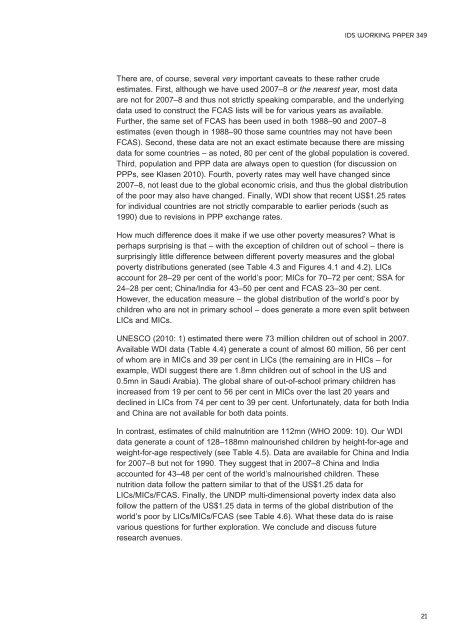Andy Sumner - Institute of Development Studies
Andy Sumner - Institute of Development Studies
Andy Sumner - Institute of Development Studies
Create successful ePaper yourself
Turn your PDF publications into a flip-book with our unique Google optimized e-Paper software.
IDS WORKING PAPER 349There are, <strong>of</strong> course, several very important caveats to these rather crudeestimates. First, although we have used 2007–8 or the nearest year, most dataare not for 2007–8 and thus not strictly speaking comparable, and the underlyingdata used to construct the FCAS lists will be for various years as available.Further, the same set <strong>of</strong> FCAS has been used in both 1988–90 and 2007–8estimates (even though in 1988–90 those same countries may not have beenFCAS). Second, these data are not an exact estimate because there are missingdata for some countries – as noted, 80 per cent <strong>of</strong> the global population is covered.Third, population and PPP data are always open to question (for discussion onPPPs, see Klasen 2010). Fourth, poverty rates may well have changed since2007–8, not least due to the global economic crisis, and thus the global distribution<strong>of</strong> the poor may also have changed. Finally, WDI show that recent US$1.25 ratesfor individual countries are not strictly comparable to earlier periods (such as1990) due to revisions in PPP exchange rates.How much difference does it make if we use other poverty measures? What isperhaps surprising is that – with the exception <strong>of</strong> children out <strong>of</strong> school – there issurprisingly little difference between different poverty measures and the globalpoverty distributions generated (see Table 4.3 and Figures 4.1 and 4.2). LICsaccount for 28–29 per cent <strong>of</strong> the world’s poor; MICs for 70–72 per cent; SSA for24–28 per cent; China/India for 43–50 per cent and FCAS 23–30 per cent.However, the education measure – the global distribution <strong>of</strong> the world’s poor bychildren who are not in primary school – does generate a more even split betweenLICs and MICs.UNESCO (2010: 1) estimated there were 73 million children out <strong>of</strong> school in 2007.Available WDI data (Table 4.4) generate a count <strong>of</strong> almost 60 million, 56 per cent<strong>of</strong> whom are in MICs and 39 per cent in LICs (the remaining are in HICs – forexample, WDI suggest there are 1.8mn children out <strong>of</strong> school in the US and0.5mn in Saudi Arabia). The global share <strong>of</strong> out-<strong>of</strong>-school primary children hasincreased from 19 per cent to 56 per cent in MICs over the last 20 years anddeclined in LICs from 74 per cent to 39 per cent. Unfortunately, data for both Indiaand China are not available for both data points.In contrast, estimates <strong>of</strong> child malnutrition are 112mn (WHO 2009: 10). Our WDIdata generate a count <strong>of</strong> 128–188mn malnourished children by height-for-age andweight-for-age respectively (see Table 4.5). Data are available for China and Indiafor 2007–8 but not for 1990. They suggest that in 2007–8 China and Indiaaccounted for 43–48 per cent <strong>of</strong> the world’s malnourished children. Thesenutrition data follow the pattern similar to that <strong>of</strong> the US$1.25 data forLICs/MICs/FCAS. Finally, the UNDP multi-dimensional poverty index data als<strong>of</strong>ollow the pattern <strong>of</strong> the US$1.25 data in terms <strong>of</strong> the global distribution <strong>of</strong> theworld’s poor by LICs/MICs/FCAS (see Table 4.6). What these data do is raisevarious questions for further exploration. We conclude and discuss futureresearch avenues.21
















